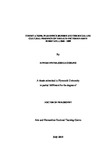Tommy Atkins, War Office Reform and the Social and Cultural Presence of the Late-Victorian Army in Britain, c.1868-1899
| dc.contributor.supervisor | Bennett, Harry | |
| dc.contributor.author | Gosling, Edward Peter Joshua | |
| dc.contributor.other | Faculty of Arts, Humanities and Business | en_US |
| dc.date.accessioned | 2016-02-26T12:32:56Z | |
| dc.date.available | 2016-02-26T12:32:56Z | |
| dc.date.issued | 2016 | |
| dc.identifier | 10300558 | en_US |
| dc.identifier.uri | http://hdl.handle.net/10026.1/4359 | |
| dc.description.abstract |
This thesis examines the development of the soldier in late-Victorian Britain in light of the movement to rehabilitate the public image of the ordinary ranks initiated by the Cardwell-Childers Reforms. Venerated in popular culture, Tommy Atkins became a symbol of British imperial strength and heroism. Socially, however, attitudes to the rank-and-file were defined by a pragmatic realism purged of such sentiments, the likes of which would characterise the British public’s relationship with their army for over thirty years. Scholars of both imperial culture and the Victorian military have identified this dual persona of Tommy Atkins, however, a dedicated study into the true nature of the soldier’s position has yet to be undertaken. The following research will seek to redress this omission. The soldier is approached through the perspective of three key influences which defined his development. The first influence, the politics of the War Office, exposes a progressive series of schemes which, cultivated for over a decade, sought to redefine the soldier through the popularisation of military service and the professionalisation of the military’s public relations strategy and apparatus. A forgotten component of the Cardwell-Childers Reforms, the schemes have not before been scrutinised. Despite the ingenuity of the schemes devised, the social rehabilitation of the soldier failed, primarily, it will be argued, because the government refused to improve his pay. The public’s response to the Cardwell-Childers Reforms and the British perception of the ordinary soldier in the decades following their introduction form the second perspective. Through surveys of the local and London press and mainstream literature, it is demonstrated the soldier, in part as a result of the reforms, underwent a social transition, precipitated by his entering the public consciousness and encouraged by a resulting fascination in the military life. The final perspective presented in this thesis is from within the rank-and-file itself. Through the examination of specialist newspaper, diary and memoir material the direct experiences of the soldiers themselves are explored. Amid the extensive public and political discussion of their nature and status, the soldier also engaged in the debate. The perspective of the rank-and-file provides direct context for the established perspectives of the British public and the War Office, but also highlights how the soldier both supported and opposed the reforms and was acutely aware of the social status he possessed. This thesis will examine the public and political treatment of the soldier in the late-nineteenth century and question how far the conflicting ideas of soldier-hero and soldier-beggar were reconciled. | en_US |
| dc.language.iso | en | en_US |
| dc.publisher | Plymouth University | en_US |
| dc.subject | British Army | en_US |
| dc.subject | Late Nineteenth-century | en_US |
| dc.subject | Soldiers | en_US |
| dc.subject | Tommy Atkins | en_US |
| dc.subject | War Office | en_US |
| dc.subject | Cardwell-Childers Reforms | en_US |
| dc.subject | The Press | en_US |
| dc.subject | Military Memoirs | en_US |
| dc.subject | Military Recruitment | en_US |
| dc.subject | Cartoons | en_US |
| dc.subject | The Broad Arrow | en_US |
| dc.subject | Thomas Hardy | en_US |
| dc.subject | Rudyard Kipling | en_US |
| dc.subject | A. E. Housman | en_US |
| dc.subject | Military History | en_US |
| dc.subject | Social History | en_US |
| dc.subject | Cultural History | en_US |
| dc.subject | Civil-military Relations | en_US |
| dc.title | Tommy Atkins, War Office Reform and the Social and Cultural Presence of the Late-Victorian Army in Britain, c.1868-1899 | en_US |
| dc.type | Thesis | |
| plymouth.version | Full version | en_US |
| dc.identifier.doi | http://dx.doi.org/10.24382/3526 |
Files in this item
This item appears in the following Collection(s)
-
01 Research Theses Main Collection
Research Theses Main


